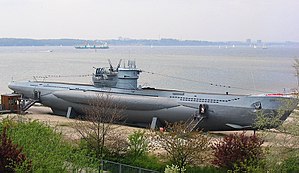
German submarine U-1305

 U-995 Type VIIC/41 at the Laboe Naval Memorial. This U-boat is almost identical to U-1305.
| |
| History | |
|---|---|
| Name | U-1305 |
| Ordered | 1 August 1942 |
| Builder | Flensburger Schiffbau-Gesellschaft, Flensburg |
| Yard number | 498 |
| Laid down | 30 July 1943 |
| Launched | 11 July 1944 |
| Commissioned | 13 September 1944 |
| Fate | Surrendered on 10 May 1945 |
| Name | S-84 |
| Commissioned | 13 February 1946 |
| Fate | Sunk on 10 October 1957 during an atomic bomb test |
| General characteristics | |
| Type | Type VIIC/41 submarine |
| Displacement | |
| Length |
|
| Beam |
|
| Height | 9.60 m (31 ft 6 in) |
| Draught | 4.74 m (15 ft 7 in) |
| Installed power |
|
| Propulsion |
|
| Speed |
|
| Range | |
| Test depth |
|
| Complement | 44-52 officers & ratings |
| Armament |
|
| Service record (Kriegsmarine) | |
| Part of: |
|
| Identification codes: | M 44 117 |
| Commanders: | |
| Operations: |
|
| Victories: |
1 merchant ship sunk (878 GRT) |
German submarine U-1305 was a Type VIIC/41 U-boat of Nazi Germany's Kriegsmarine during World War II.

She was ordered on 1 August 1942, and was laid down on 30 July 1943, at Flensburger Schiffbau-Gesellschaft, Flensburg, as yard number 498. She was launched on 11 July 1944, and commissioned under the command of Oberleutnant zur See Helmuth Christiansen on 13 September 1944.[2]

Design
German Type VIIC/41 submarines were preceded by the heavier Type VIIC submarines. U-1305 had a displacement of 769 tonnes (757 long tons) when at the surface and 871 tonnes (857 long tons) while submerged. She had a total length of 67.10 m (220 ft 2 in), a pressure hull length of 50.50 m (165 ft 8 in), an overall beam of 6.20 m (20 ft 4 in), a height of 9.60 m (31 ft 6 in), and a draught of 4.74 m (15 ft 7 in). The submarine was powered by two Germaniawerft F46 four-stroke, six-cylinder supercharged diesel engines producing a total of 2,800 to 3,200 metric horsepower (2,060 to 2,350 kW; 2,760 to 3,160 shp) for use while surfaced, two AEG GU 460/8-276 double-acting electric motors producing a total of 750 metric horsepower (550 kW; 740 shp) for use while submerged. She had two shafts and two 1.23 m (4 ft) propellers. The boat was capable of operating at depths of up to 230 metres (750 ft).[3]

The submarine had a maximum surface speed of 17.7 knots (32.8 km/h; 20.4 mph) and a maximum submerged speed of 7.6 knots (14.1 km/h; 8.7 mph). When submerged, the boat could operate for 80 nautical miles (150 km; 92 mi) at 4 knots (7.4 km/h; 4.6 mph); when surfaced, she could travel 8,500 nautical miles (15,700 km; 9,800 mi) at 10 knots (19 km/h; 12 mph). U-1305 was fitted with five 53.3 cm (21 in) torpedo tubes (four fitted at the bow and one at the stern), fourteen torpedoes, one 8.8 cm (3.46 in) SK C/35 naval gun, (220 rounds), one 3.7 cm (1.5 in) Flak M42 and two 2 cm (0.79 in) C/30 anti-aircraft guns. The boat had a complement of between forty-four and fifty-two.[3]

Service history
On 10 May 1945, U-1305 surrendered at Loch Eriboll, Scotland. She was later transferred to Lisahally on 14 May 1945.[2]

Post war service
The TNC allocated U-1305 to the Soviet Union. On 4 December 1945, she arrived in Libau, Latvia, as British N-class N25. On 13 February 1946, the Soviet Navy allocated her to the Baltic Fleet. She was renamed S-84 on 9 June 1949, then sent to the reserve fleet on 30 December 1955. S-84 went to the Northern Fleet as a test hulk and was later sunk in the Barents Sea on 10 October 1957, during an atomic bomb test off of Novaya Zemlya.[2]

The wreck now lies approximately at 70°42′11″N 54°36′00″E / 70.703°N 54.6°E.

Summary of raiding history
| Date | Ship Name | Nationality | Tonnage (GRT) |
Fate[4] |
|---|---|---|---|---|
| 24 April 1945 | Monmouth Coast | 878 | Sunk |
See also
References
- ^ Helgason, Guðmundur. "Helmuth Christiansen". German U-boats of WWII - uboat.net. Retrieved 31 March 2016.
- ^ a b c Helgason, Guðmundur. "U-1305". German U-boats of WWII - uboat.net. Retrieved 31 March 2016.
- ^ a b Gröner 1991, pp. 43–44.
- ^ Helgason, Guðmundur. "Ships hit by U-1305". German U-boats of WWII - uboat.net. Retrieved 31 March 2015.
Bibliography
- Busch, Rainer; Röll, Hans-Joachim (1999). German U-boat commanders of World War II : a biographical dictionary. Translated by Brooks, Geoffrey. London, Annapolis, Md: Greenhill Books, Naval Institute Press. ISBN 1-55750-186-6.
- Busch, Rainer; Röll, Hans-Joachim (1999). Deutsche U-Boot-Verluste von September 1939 bis Mai 1945 [German U-boat losses from September 1939 to May 1945]. Der U-Boot-Krieg (in German). Vol. IV. Hamburg, Berlin, Bonn: Mittler. ISBN 3-8132-0514-2.
- Gröner, Erich; Jung, Dieter; Maass, Martin (1991). U-boats and Mine Warfare Vessels. German Warships 1815–1945. Vol. 2. Translated by Thomas, Keith; Magowan, Rachel. London: Conway Maritime Press. ISBN 0-85177-593-4.
See what we do next...
OR
By submitting your email or phone number, you're giving mschf permission to send you email and/or recurring marketing texts. Data rates may apply. Text stop to cancel, help for help.
Success: You're subscribed now !
